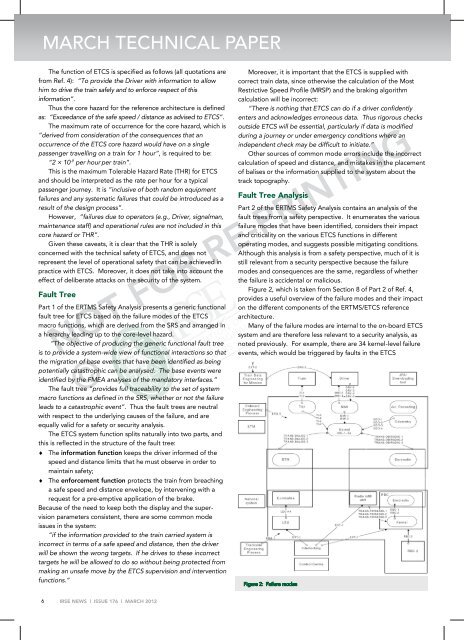IRSE News 176 Mar 12 with Watermark.pdf
IRSE News 176 Mar 12 with Watermark.pdf
IRSE News 176 Mar 12 with Watermark.pdf
Create successful ePaper yourself
Turn your PDF publications into a flip-book with our unique Google optimized e-Paper software.
MARCH TECHNICAL PAPER<br />
The function of ETCS is specified as follows (all quotations are<br />
from Ref. 4): “To provide the Driver <strong>with</strong> information to allow<br />
him to drive the train safely and to enforce respect of this<br />
information”.<br />
Thus the core hazard for the reference architecture is defined<br />
as: “Exceedance of the safe speed / distance as advised to ETCS”.<br />
The maximum rate of occurrence for the core hazard, which is<br />
“derived from consideration of the consequences that an<br />
occurrence of the ETCS core hazard would have on a single<br />
passenger travelling on a train for 1 hour”, is required to be:<br />
“2 × 10 -9 per hour per train”.<br />
This is the maximum Tolerable Hazard Rate (THR) for ETCS<br />
and should be interpreted as the rate per hour for a typical<br />
passenger journey. It is “inclusive of both random equipment<br />
failures and any systematic failures that could be introduced as a<br />
result of the design process”.<br />
However, “failures due to operators (e.g., Driver, signalman,<br />
maintenance staff) and operational rules are not included in this<br />
core hazard or THR”.<br />
Given these caveats, it is clear that the THR is solely<br />
concerned <strong>with</strong> the technical safety of ETCS, and does not<br />
represent the level of operational safety that can be achieved in<br />
practice <strong>with</strong> ETCS. Moreover, it does not take into account the<br />
effect of deliberate attacks on the security of the system.<br />
Fault Tree<br />
Part 1 of the ERTMS Safety Analysis presents a generic functional<br />
fault tree for ETCS based on the failure modes of the ETCS<br />
macro functions, which are derived from the SRS and arranged in<br />
a hierarchy leading up to the core-level hazard.<br />
“The objective of producing the generic functional fault tree<br />
is to provide a system-wide view of functional interactions so that<br />
the migration of base events that have been identified as being<br />
potentially catastrophic can be analysed. The base events were<br />
identified by the FMEA analyses of the mandatory interfaces.”<br />
The fault tree “provides full traceability to the set of system<br />
macro functions as defined in the SRS, whether or not the failure<br />
leads to a catastrophic event”. Thus the fault trees are neutral<br />
<strong>with</strong> respect to the underlying causes of the failure, and are<br />
equally valid for a safety or security analysis.<br />
The ETCS system function splits naturally into two parts, and<br />
this is reflected in the structure of the fault tree:<br />
NOT FOR RE-PRINTING<br />
©<br />
The information function keeps the driver informed of the<br />
speed and distance limits that he must observe in order to<br />
maintain safety;<br />
The enforcement function protects the train from breaching<br />
a safe speed and distance envelope, by intervening <strong>with</strong> a<br />
request for a pre-emptive application of the brake.<br />
Because of the need to keep both the display and the supervision<br />
parameters consistent, there are some common mode<br />
issues in the system:<br />
“if the information provided to the train carried system is<br />
incorrect in terms of a safe speed and distance, then the driver<br />
will be shown the wrong targets. If he drives to these incorrect<br />
targets he will be allowed to do so <strong>with</strong>out being protected from<br />
making an unsafe move by the ETCS supervision and intervention<br />
functions.”<br />
Moreover, it is important that the ETCS is supplied <strong>with</strong><br />
correct train data, since otherwise the calculation of the Most<br />
Restrictive Speed Profile (MRSP) and the braking algorithm<br />
calculation will be incorrect:<br />
“There is nothing that ETCS can do if a driver confidently<br />
enters and acknowledges erroneous data. Thus rigorous checks<br />
outside ETCS will be essential, particularly if data is modified<br />
during a journey or under emergency conditions where an<br />
independent check may be difficult to initiate.”<br />
Other sources of common mode errors include the incorrect<br />
calculation of speed and distance, and mistakes in the placement<br />
of balises or the information supplied to the system about the<br />
track topography.<br />
Fault Tree Analysis<br />
Part 2 of the ERTMS Safety Analysis contains an analysis of the<br />
fault trees from a safety perspective. It enumerates the various<br />
failure modes that have been identified, considers their impact<br />
and criticality on the various ETCS functions in different<br />
operating modes, and suggests possible mitigating conditions.<br />
Although this analysis is from a safety perspective, much of it is<br />
still relevant from a security perspective because the failure<br />
modes and consequences are the same, regardless of whether<br />
the failure is accidental or malicious.<br />
Figure 2, which is taken from Section 8 of Part 2 of Ref. 4,<br />
provides a useful overview of the failure modes and their impact<br />
on the different components of the ERTMS/ETCS reference<br />
architecture.<br />
Many of the failure modes are internal to the on-board ETCS<br />
system and are therefore less relevant to a security analysis, as<br />
noted previously. For example, there are 34 kernel-level failure<br />
events, which would be triggered by faults in the ETCS<br />
Figure 2: Failure modes<br />
6<br />
<strong>IRSE</strong> NEWS | ISSUE <strong>176</strong> | MARCH 20<strong>12</strong>
















